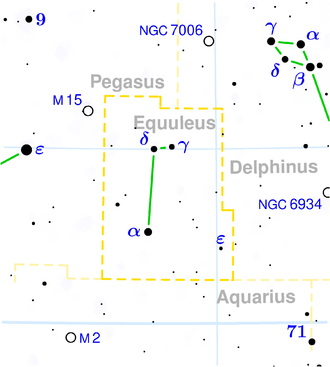NGC 7040
| Galaxy NGC 7040 |
|
|---|---|

|
|
| SDSS recording | |
| AladinLite | |
| Constellation | To fill |
|
Position equinox : J2000.0 , epoch : J2000.0 |
|
| Right ascension | 21 h 13 m 16.5 s |
| declination | + 08 ° 51 ′ 54 ″ |
| Appearance | |
| Morphological type | S? |
| Brightness (visual) | 14.0 mag |
| Brightness (B-band) | 14.9 mag |
| Angular expansion | 0.9 ′ × 0.8 ′ |
| Position angle | 150 ° |
| Surface brightness | 13.5 mag / arcmin² |
| Physical data | |
| Redshift | 0.020399 ± 0.000026 |
| Radial velocity | (6115 ± 8) km / s |
|
Stroke distance v rad / H 0 |
(281 ± 20) x 10 6 ly (86.2 ± 6.0) Mpc |
| history | |
| discovery | Mark Walrod Harrington |
| Discovery date | August 18, 1882 |
| Catalog names | |
| NGC 7040 • UGC 11701 • PGC 66366 • CGCG 401-008 • MCG + 01-54-004 • IRAS 21108 + 0839 • 2MASX J21131651 + 0851541 • HIPASS J2113 + 08 | |
NGC 7040 is the name for a spiral galaxy in the constellation Equuleus . It is around 281 million light years from the Milky Way .
NGC 7040 was discovered on August 18, 1882 by the American astronomer Mark Walrod Harrington .
